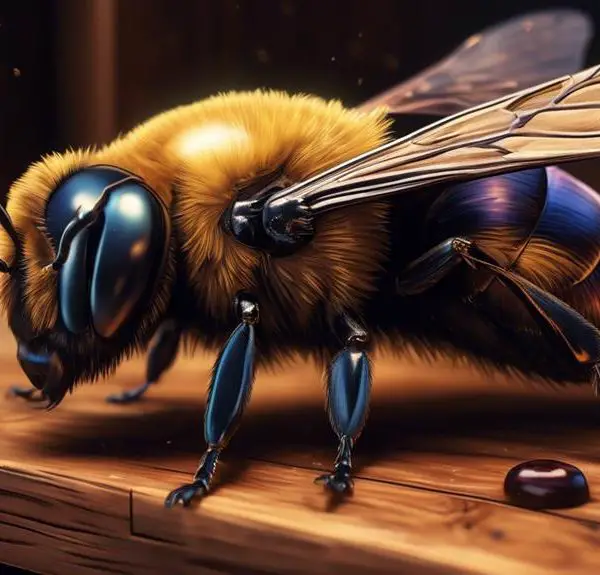Uncover the secret to saving your deck from destructive carpenter bees with our insightful solutions and preventative measures.

Carpenter Bees Destroying My Deck
Is it possible that the uninvited holes in your deck are the handiwork of carpenter bees? You've probably noticed these large, black and yellow insects hovering around your home, particularly in areas where wood is exposed. They're not just an annoyance – they're a potential threat to the integrity of your deck.
As they burrow into the wood to build their nests, they can cause significant damage. But what can you do about it? Well, let's explore some solutions together, shall we?
Key Takeaways
- Carpenter bees can cause significant damage to wooden structures, including decks.
- Signs of a carpenter bee infestation include small holes in wood, sawdust or wood shavings, staining around holes, buzzing sounds, and bees returning to the same spot.
- Carpenter bee damage weakens the structural integrity of the deck and can attract woodpeckers, causing further damage.
- Effective methods of control include using insecticidal dust, spraying residual insecticide, plugging bee tunnels, and regularly maintaining the deck to prevent future infestations.
Understanding Carpenter Bees
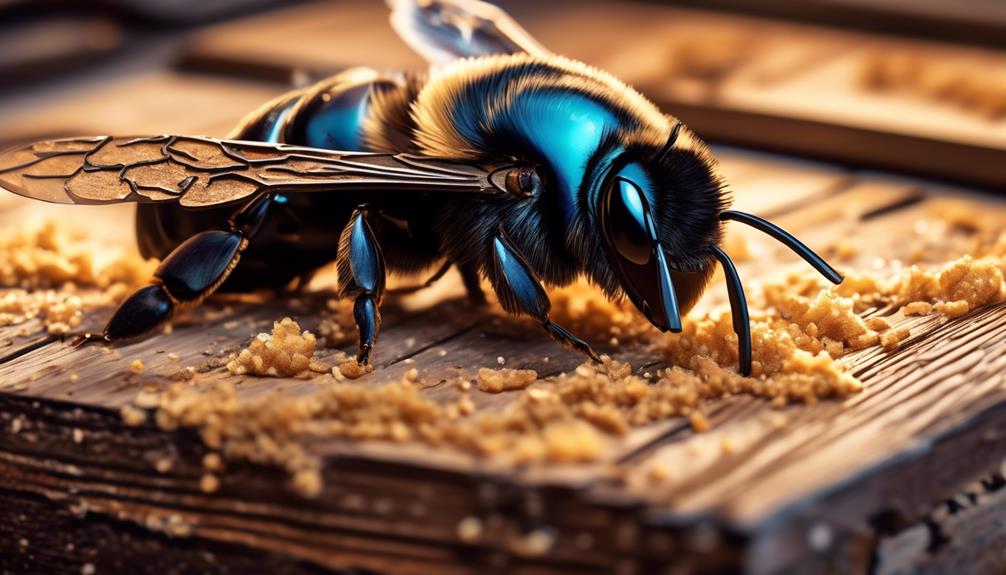
To truly grasp why your deck may be at risk, you need to understand the nature and behavior of carpenter bees. These bees aren't your typical honey producers. Instead, they're solitary insects with a penchant for burrowing into wood. Here's where the trouble starts for your deck.
Carpenter bees, specifically the females, bore into wood to lay their eggs. They're not eating the wood but are rather creating a safe haven for their offspring. However, this 'construction' process can cause significant damage to wooden structures, particularly if the bees return year after year.
Unlike other bees, carpenter bees don't live in colonies. Each female is independent, making her own nest. You might think this reduces the risk, but it's quite the opposite. With potentially dozens of females each drilling their own nest, the cumulative damage can be substantial.
Moreover, the bees don't discriminate between treated and untreated wood. Regardless of whether you've stained, painted, or sealed your deck, it's still at risk. Understanding this behavior can help you identify signs of infestation early on and take appropriate action to protect your deck.
Signs of Carpenter Bee Infestation
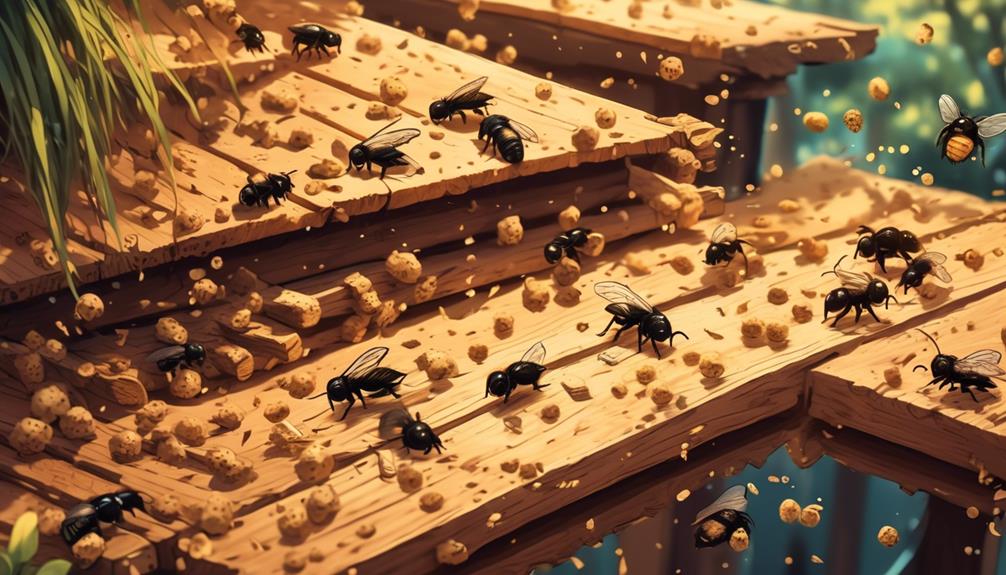
Spotting a carpenter bee infestation in your deck isn't always straightforward, but there are telltale signs you should be aware of. These signs can be physical or behavioral, and understanding them can help you address the issue promptly.
Physical Signs | What It Indicates | Behavioral Signs |
|---|---|---|
Small, round holes in wood | Entry and exit points for bees | Loud buzzing sounds |
Sawdust or wood shavings underneath holes | Excavation activity of bees | Bees hovering near deck |
Staining around holes | Waste expulsion from bees | Aggressive behavior towards humans |
Tunnels within the wood | Nesting and breeding spaces | Bees returning to same spot |
Physical signs are often the first indications of a carpenter bee infestation. You may notice small, round holes in the wood of your deck. These serve as entry and exit points for the bees. Accompanying these holes, you'll likely find sawdust or wood shavings, a byproduct of their excavation activity. Staining around these holes can also occur from the expulsion of waste by the bees.
Behavioral signs are equally important. You might hear loud buzzing sounds or see bees hovering near your deck. Bees are known to return to the same spot, signaling a possible infestation. Recognizing these signs can help you take swift action.
Potential Damage to Your Deck
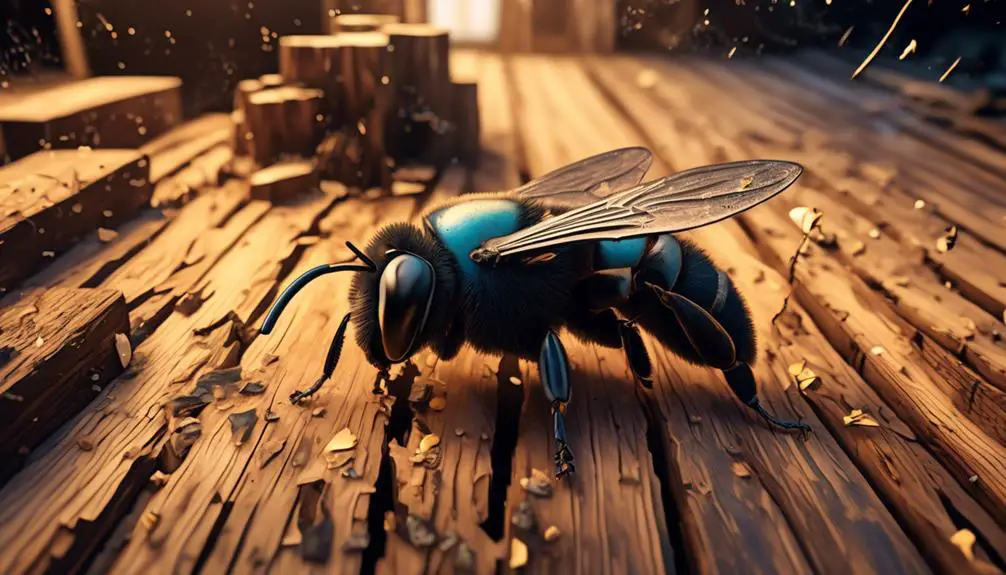
Understanding the signs of a carpenter bee infestation is crucial, as these pests can cause extensive damage to your deck if left unchecked. The primary form of damage comes from the bee's nesting habits. Unlike termites, carpenter bees don't eat the wood but drill into it to create tunnels, or galleries, for their offspring.
These galleries compromise the structural integrity of your deck. Over time, the repeated drilling and nesting can cause sections of your deck to weaken and potentially collapse, posing a significant safety risk. Additionally, although a single bee's tunnel may seem insignificant, an infestation can result in numerous galleries, expanding the damage exponentially.
Another aspect of potential harm is the staining from the bees' excrement. This staining not only mars the aesthetic appeal of your deck but also indicates a severe infestation. Furthermore, the noise created by the bees' constant drilling can also be a nuisance.
Lastly, carpenter bees attract woodpeckers, which exacerbate the damage by drilling into the wood to feast on the bee larvae. Therefore, immediate actions are necessary upon noticing the first signs of an infestation.
Effective Methods of Control
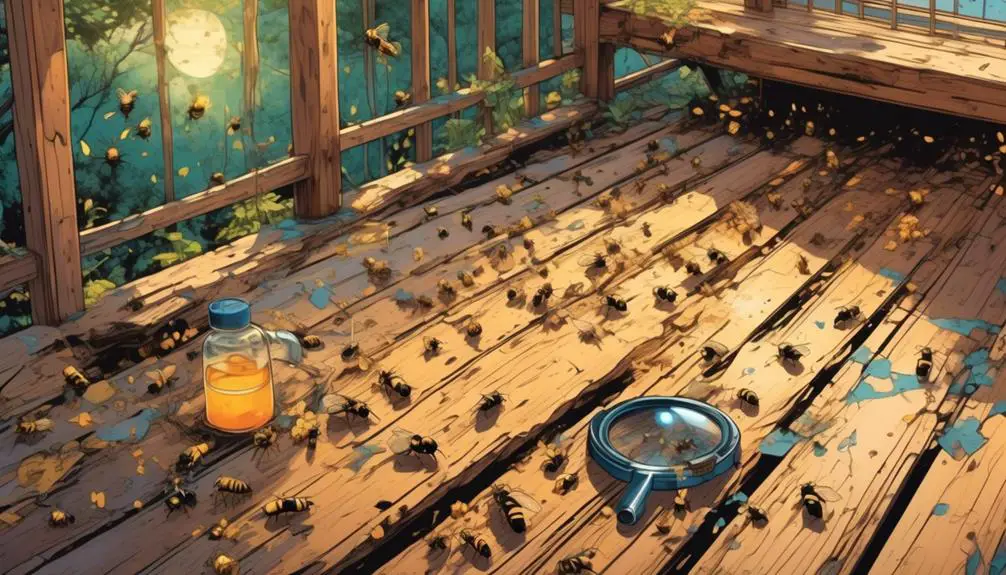
Several effective strategies can help you control a carpenter bee infestation, ensuring your deck's longevity and structural integrity.
One such method is the use of insecticidal dust, which you can apply directly into the bee tunnels. This dust sticks to the bees, causing them to die off slowly. However, it's essential to reapply this dust every few days for optimal results.
Another approach is the use of a residual insecticide, which you can spray on the deck's surface. This method discourages bees from boring into the wood, as they'll avoid areas that have been treated. Be sure to choose an insecticide labeled safe for your specific type of wood.
Alternatively, consider physical control methods. One such method is to plug the bee tunnels with steel wool or a dowel, preventing the bees from returning. This method is most effective when used immediately after the bees have emerged in spring.
Lastly, maintenance is key. Regularly paint or varnish your deck, as carpenter bees prefer untreated wood.
Preventing Future Infestations
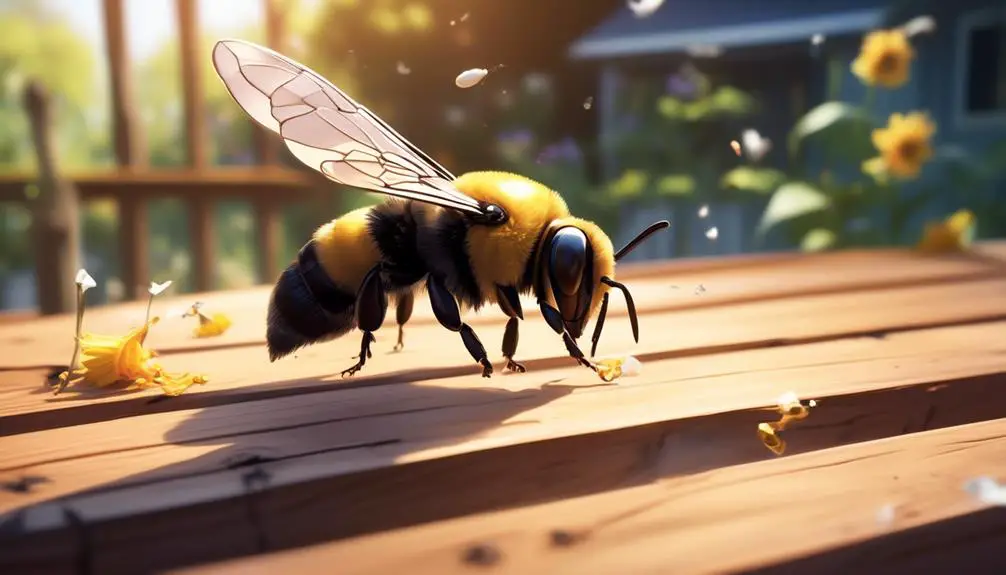
While controlling an existing carpenter bee infestation is crucial, it's equally important to take proactive measures to prevent future invasions. Carpenter bees are attracted to untreated, exposed wood. Therefore, painting or staining your deck is your first line of defense. These bees are less likely to target painted or stained wood. Choose a solid stain or paint over a clear sealer.
Next, consider insecticide treatments. Apply an insecticide dust to the carpenter bee holes and cracks in your deck. Effective insecticides include those with active ingredients such as deltamethrin or cyfluthrin. Remember to wear protective clothing and follow the product instructions.
Seal off the bee holes once you've treated them with insecticide. Use a wood filler or a piece of wooden dowel coated with wood glue. This not only deters new bees from reusing the holes, but it also traps and kills any remaining bees inside.
Lastly, maintain your deck regularly. Regular maintenance, including checking for new holes, repainting, and applying insecticide when necessary, can help you stay ahead of any new infestations. Prevention is always better than cure when it comes to carpenter bee damage.
Conclusion
In summary, if you're noticing holes and sawdust on your deck, carpenter bees may be the culprits. These pests can cause significant damage over time.
Fortunately, effective control methods can curb their destruction, from insecticides to traps.
Remember, prevention is key. Regularly seal and paint your deck to deter these wood-boring insects.
No need to let carpenter bees ruin your outdoor enjoyment; with diligent care, you can protect your deck and keep them at bay.

